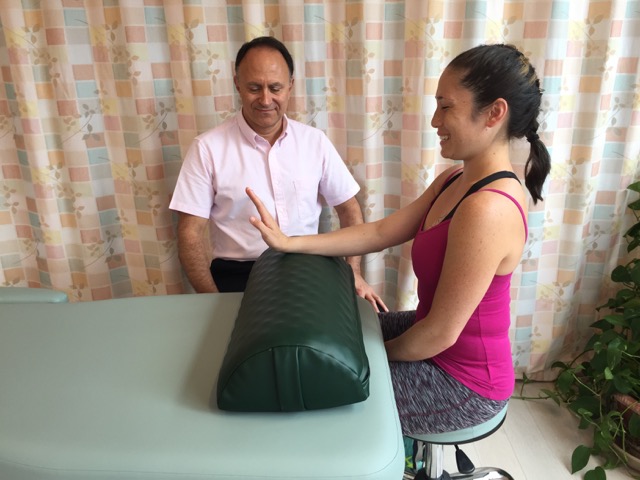Assessment/ Diagnosis
Assessment/diagnosis of wrist strain, sprain, and tendinitis is done using active and passive range of motion (ROM) as well as manual resistance; in each case, pain is considered to be a positive finding. The general rule is that active ROM will be positive for strains/tendinitis and sprains; passive ROM will be positive only for sprains; and manual resistance will be positive only for strains/tendinitis. However, active and passive ROM can be positive for a strain/tendinitis of the antagonistic musculature as well.

Orthopedic assessment testing: active range of motion of the hand at the wrist joint. Permission: Joseph E. Muscolino.
To assess a client/patient with a possible wrist strain/sprain/tendinitis, perform all four ranges of motion actively and passively, and then perform manual resistance for each of the four ranges of motion.
Active range of motion (ROM) assessment test: Active ROM will elicit pain and be positive for a wrist strain (and/or tendinitis) of mover musculature of the action performed because that musculature contracts and its tendons are placed under tension. It will also elicit pain and be positive for a sprain because the joint is moved and therefore ligamentous tissue is stressed. It is also possible for active ROM to elicit pain and be positive for a strain/tendinitis of the antagonistic musculature because it is stretched.
Passive range of motion (ROM) assessment test: Passive ROM will elicit pain and be positive for a wrist sprain because the joint is moved and therefore the ligamentous tissue is stressed. It will not show positive for a strain/tendinitis of mover musculature because that musculature did not contract and was not stretched. However, it can also elicit pain and be positive for a strain/tendinitis of the antagonistic musculature because it is stretched.
Manual resistance (MR) assessment test: MR in which the joint does not move at all (in other words, the patient’s/client’s contraction is isometric) will elicit pain and be positive for a wrist strain (and/or tendinitis) of the mover musculature that contracts because it is working. It will not show positive for a sprain because the joint did not move; it will also not show positive for a strain/tendinitis of the antagonistic musculature because that musculature did not contract and was not stretched.
ACTIVE RANGE OF MOTION (AROM):
Flexion – positive for (anterior) flexor strain/tendinitis and/or for sprain
Extension – positive for (posterior) extensor strain/tendinitis and/or for sprain
Radial deviation – positive for (lateral) radial deviation strain/tendinitis and/or for sprain
Ulnar deviation – positive for (medial) ulnar deviation strain/tendinitis and/or for sprain
In each case, it the test is negative, the client does not have a strain/tendinitis or a sprain.
PASSIVE RANGE OF MOTION (PROM):
In any direction is positive for a sprain.
If each case, if the test is negative, the client does not have a sprain.
Note: Active ROM and passive ROM can also be positive for a strain/tendinitis for musculature that is antagonistic to the action performed.
MANUAL RESISTANCE (MR):
Flexion – positive for (anterior) flexor strain/tendinitis
Extension – positive for (posterior) extensor strain/tendinitis
Radial deviation – positive for (lateral) radial deviation strain/tendinitis
Ulnar deviation – positive for (medial) ulnar deviation strain/tendinitis
In each case, if the test is negative, the client does not have a strain.
If a strain or tendinitis is assessed, the next stage of assessment is to palpate each of the muscles of that region to determine which muscles are affected.
Differential diagnosis/assessment
Wrist sprains, strains, and tendinitis cause symptoms of pain and weakness in the wrist region, and occasionally into the forearm itself. Therefore, any condition that causes these symptoms can be confused with wrist sprain/strain/tendinitis, however, most of these other conditions do not result in increased pain with use of the wrist itself. Examples of these other conditions are referral conditions from elsewhere in the body such as cervical discs and myofascial trigger points. Therefore, active ROM, passive ROM, and manual resistance of the wrist are usually successful at differentially assessing these conditions from each other.
One possible exception is carpal tunnel syndrome (CTS), which can result in increased wrist pain with use of the wrist. In this case, the differential diagnosis/assessment rests on symptoms referring into the hand; CTS includes referral into the hand whereas wrist sprains, strains, and tendinitis do not.
Note: If a wrist strain is assessed, it is important to assess for the presence of tennis or golfer’s elbow because each of these conditions often occurs together with wrist strains/tendinitis because they are overuse syndromes of musculature that cross the wrist joint. If a sprain or strain is assessed, but especially a sprain, it is important to assess for joint dysfunction of the carpal bones because these conditions often occur together.


